
Caring for a Constellation of Skin Microbiota
“Imagine you could shield your skin microbiota from the harmful effects of sun radiation.” This invitation to dream about the future of sun care and skincare comes from Òscar Expósito, CEO, CSO, and Co-Founder of Vytrus Biotech.
Based in Barcelona, Spain, the company specializes in “the use of plant cell cultures to develop high-value ingredients” for our industry.
In 2009, “Vytrus Biotech was established as a spin-off company associated with the Faculty of Pharmacy at the University of Barcelona, specifically within the Group of Research in Plant Biotechnology.” Vytrus’ founders Dr. Oscar Expósito and Albert Jané saw potential for this plant stem cell culture technology in the cosmetic ingredient marketplace.
What was “at the beginning a niche technology in the sector [is], with the passage of time, becoming the center of product developments for our clients,” Expósito tells me. This is due, he explains, “to the possibility of bringing new applications and metabolic pathways in the skin system and respectfully working with any plant species while providing a sustainable solution to the industry.” Vytrus’ technology is “able to save more than 99% of water and arable soil consumption compared to traditional plant extracts methods.”
I chose to include Vytrus in this article about the ‘science of tomorrow’ not only because biotechnology is significant to the future of industry but also because of the innovation that Expósito hinted at when he asked us to “imagine you could shield your skin microbiota from the harmful effects of sun radiation.”
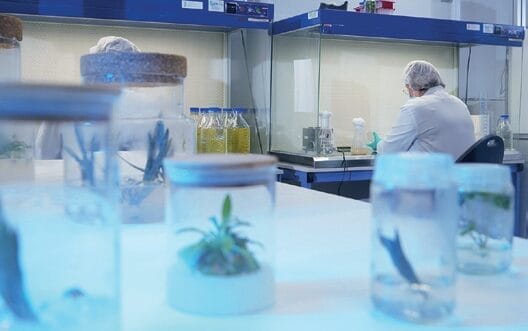
Early this year, Vytrus launched Photobiome™, a 100% natural and COSMOS approved ingredient, comprising a prebiotic blend derived from pomegranate and cotton stem cells. Expósito calls it “a groundbreaking microbiota photoprotector” and “a substantial leap in the realm of microbial antioxidants.”
The team at “Vytrus has identified specific skin microbiota species that demonstrate its specific ability to interact with solar radiation,” explains Expósito, adding that the company “refers to this system, encompassing these species and their ecosystem, as the Photobiome Factor.”
“It has been shown that these certain cutaneous microbiota species can synthesize and release certain molecular components metabolized by the interaction of the microbiota with solar radiation that contribute to the skin’s natural photodefense system;” and the company calls these molecules Solar Postbiotics.
Photobiome™ then nourishes and protects the Photobiome Factor, enhancing “the generation of solar postbiotics, providing benefits in photoprotection and the photoaging process,” according to Expósito. The new active ingredient “plays a pivotal role in modulating bacterial metabolism and stimulating the microbiota to generate its own photo-defense molecules.”
“In trials involving sun-exposed volunteers, Photobiome™ effectively guards the microbiota and skin cells against the photo-oxidative stress induced by harmful sun radiation.” Outlining the potential applications of the ingredient, Expósito expects beauty makers to use the new active to develop:
- Preventive and treatment-oriented antioxidant formulations
- Solutions to address photoaging concerns, including products designed for wrinkle care in areas like crow’s feet, the lip contour, and the eye area
- Preventive and reparative sun care formulations
- Treatments that enhance skin appearance, targeting hyperpigmentation, elasticity, and firmness.”
Bringing Beauty Back Down to Earth
Up in Helsinki, Finland, the team at Uute Scientific Oy is also concerned with the care and feeding of the skin microbiome – as well as with the magnificence of dirt.
Founded in 2019, Uute Scientific sources its innovative cosmetic and personal care ingredient from soil itself … or rather from plant-based compost. “We would never dream of digging up the forest floor,” Rita Nordin, Co-Founder and CMO, tells me. “All our starting materials are from renewable and sustainable sources and reputable partners. Each one is carefully selected based on its unique bacterial composition and other characteristics.” INCI has termed their world-first ingredient Humus Extract; the branded name is Re-Connecting Nature™.
“1 g of Re-Connecting Nature™ microbial extract contains approximately 700 different inactivated bacterial species found in Finland’s rich and diverse natural environment,” as Nordin explains. “The unique complexity of this community of bacteria has many slow-growing species that cannot be grown under laboratory conditions. But the real strength comes from the sheer diversity of microbes involved. Unlike probiotic products, which typically contain just a few species, our microbial extract contains thousands, including bacteria, archaea, and eukaryotes.”
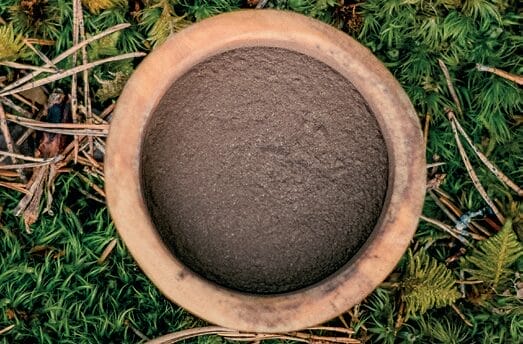
“Together,” she emphasizes, “this diverse spectrum provides the immune system with a complex stimulus; something that can’t be achieved by just a few species. It all adds up to a more natural balance; one associated with enhanced skin health, resilience, comfort, and appearance.”
As a company, Uute Scientific is dedicated to “life without immune-mediated diseases” and serves a range of industries with its soil-microbe technology.
Aki Sinkkonen, PhD, Docent of Environmental Ecology; Heikki Hyöty, MD, PhD, Professor of Virology at Tampere University; and Olli Laitinen, PhD, Docent of Molecular Virology, are credited with the concept of a biodiversity-enhancing powder for immune system support. And the foundational research that made Re-Connecting Nature™ possible took place at the University of Tampere and the University of Helsinki.
Nordin tells me that, to date, Re-Connecting Nature™ has been incorporated in “textiles and play doughs.” And research is currently underway on the value of bringing this microbe extract into the built environment quite literally: at “University College of London (UCL) Richard Beckett, an Associate Professor in Architecture at the Bartlett School of Architecture, is developing biologically active building materials that can ‘rewild’ the indoor environment – bringing microbial diversity associated with nature directly into the home,” shares Nordin.
“He and his team are using our Re-Connecting Nature™ microbial extract for that study,” she says adding that, “like all of us at Uute Scientific, Richard believes that exposure to microbes associated with natural environments plays a fundamental role in shaping immunoregulatory health.”
Of course, skincare, haircare, and color cosmetics are among the indoor product categories the ingredient is well suited for. And Nordin points to “over 60 different cosmetic products from different brands on the market from Scandinavia to Asia” that are formulated with Re-Connecting Nature™. A number that will go up significantly in the New Year, “when new beauty products are launched in the US as well,” she says.
A Matter for Circular Packaging
In the world of beauty packaging, the matter in question is almost only ever paper, plastic, glass, and/or metal. Practical and sustainable material innovation is quite rare, which is why I have been enchanted by Sulapac for many years now.
“Sulapac materials are safe for people and the planet, circular by design, and easy to adopt: they are processable with existing plastic converting machinery and designed to fulfill the criteria of the most demanding luxury brands,” explains Co-Founder Laura Tirkkonen-Rajasalo, who serves as Director of Quality Assurance and Regulatory Affairs. As neatly as she states it, this is much more easily said than done.
“Made of biodegradable biopolymers and sustainable fillers like side stream wood or natural clay minerals, Sulapac materials are bio-based and industrially compostable. They biodegrade without leaving persistent microplastics or toxic load behind, even if accidentally leaked into the environment,” Tirkkonen-Rajasalo tells me.
The novel packaging materials in the Sulapac portfolio are also “recyclable by design,” she says; “Their suitability for both mechanical and chemical recycling has been demonstrated by independent third parties. Furthermore, they can already be made with recycled content. Sulapac materials have a low global warming potential compared to conventional plastics and the usage of recycled content further decreases their carbon footprint.”
And when Tirkkonen-Rajasalo says that Sulapac materials are processable with existing plastic converting machinery, she means blow molding, injection molding, extrusion, 3D printing, and thermoforming. An important selling point, since requiring new machinery is a very costly barrier to adopting new materials.
The company, which like Uute Scientific, is headquartered in Finland, was founded in 2016, and a first beauty product packaged in a Sulapac material was launched to the consumer market in 2018, when the Atopik brand from skincare manufacturer Naviter Oy chose it for their All Over Balm.
Sulapac materials make sense for cosmetic and personal care brands not only because the look and feel is appropriate for our industry but also because of their “exceptional barrier properties.” Sulapac “can be used in direct contact with water-based cosmetic formulas and it keeps the precious product inside fresh and stable as long as needed,” says Tirkkonen-Rajasalo. And the various materials can meet beauty makers’ other “functional needs like high heat resistance, reusability, impact strength, or flexibility.” The materials are suitable for “skincare packaging, makeup pens, compacts, point-of-sale displays, logistic trays, fragrance caps, prototyping,” and more. Of course the environmental sustainability is quite the advantage as well.
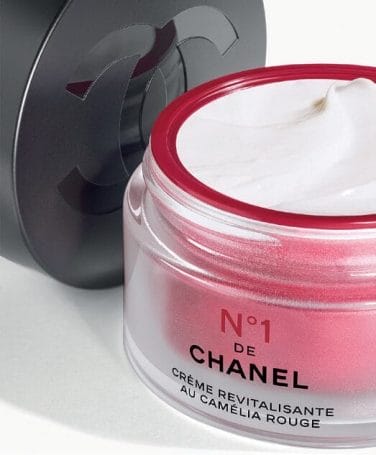
Today, you may have come across a Sulapac material on a No1 de CHANEL product lid. The company’s work with that beauty range is an example of what Tirkkonen-Rajasalo describes as a joint development project. The lids are custom to CHANEL and “contain camelia seed shells, a leftover from using camelia seed oil in the cosmetic product itself. So, we can utilize customers’ own waste streams to create fully functional packaging that has [a] low carbon footprint and leaves no microplastic or toxic load behind.”
The company continues to innovate, launching Sulapac Luxe and Sulapac Luxe Flex just this year. Both of the new materials, Tirkkonen-Rajasalo tells me, “have received tremendous interest within the cosmetic sector.” And she explains their most likely applications, saying, “these materials can be used as a replacement for hard plastics such as ABS [Acrylonitrile Butadiene Styrene]. They are ideal for cosmetic packaging, including lids, jars, fragrance caps, and compacts.”
At present, Sulapac is working mostly with “brands from the premium or luxury sector with ambitious sustainability targets. There are small and medium-sized cosmetic brands utilizing Sulapac packaging too, many of which are served today by our partner APG Europe, who has a broad range of ready-made Sulapac packaging in its offering with lower MOQs compared to some other partners.”
“If there is magic on this planet, it is contained in water.”*
Beauty industry suppliers imagine and invent and innovate new technologies in many ways. And one of my favorite way to learn about these new technologies is through conversations with the people who are actually dreaming up the science of tomorrow, or at least with people who are involved (or shall we say invested) in commercializing those innovations.
I recently learned about Hydrosome H20 through one such conversation. Hydrosome H20 is water. But it’s water with improved bioavailability; Hydrosome H20 is a more efficient hydrator, a more effective active delivery mechanism, and has applications in the production of fermented personal care ingredients too.
The venture behind this water technology, is a platform bio-tech company working to improve the performance of products across sectors, says Bob Jacobs President of the Consumer Products division at Hydrosome.
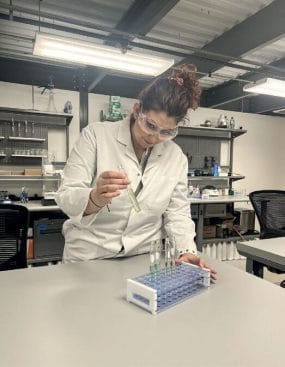
“Hydrosome H20,” he tells me, “is a unique and patented composition of water.” And Jacobs goes on to explain that the technology “involves treating ultra-pure water through a unique form of hydrodynamic cavitation. We use force and pressure to impart small chemical and physical changes to the water that are enabled by a stable concentration of ultra-fine bubbles. The changes improve the flow of water and nutrients across cell membranes.”
Established in 2021 and headquartered in Westmont, Illinois (US), Hydrosome, he says, is the “first to bring this technology to the consumer products space; and [we] have several additional patents pending that cover its use in personal care products.” In fact, the water tech company “began validating the application of [Hydrosome H2O] for personal care in 2022, through work with TRI Princeton, showing the improved penetration of active ingredients into the skin.”
And this more bioavailable water has applications in liquid supplements, or beauty-from-within products, too: “In a 12-week clinical trial with a collagen beverage containing Hydrosome H2O,” Jacobs tells me, “we delivered clinically significant improvements in firmness and elasticity.”
It’s worth noting that Hydrosome technology can be fitted in-line at any manufacturing facility that’s already using ultra-pure water. And the physical footprint for adding in the tech is, I am told, quite small. “Hydrosome H2O is GRAS certified and can be used as a direct substitute for DI water in existing formulations.” DI refers to deionized, or water that has been distilled to remove dissolved mineral salts and other impurities.
All of us – beauty makers included – rely heavily on the magic of water.* “The technology was originally developed for the pharmaceutical industry and is used there today for several medical applications,” says Jacobs; and of course the team is “always exploring additional applications.” But having spent 20+ years in brand management at P&G, he’s excited to see beauty “brands looking to improve the efficacy of existing formulations to generate new claims, as well as brands with difficult to permeate ingredients …benefit from our technology.”
(*That quote at the start of this section is from Loren Eiseley, an anthropologist and philosopher originally from Lincoln, Nebraska (US). I don’t know his work; Google helped me find his apt words.)
Reimagining the Science of Manufacturing Beauty
90% of all cosmetic and personal care products are emulsions; and according to the cosmetics glossary on CosmeticObs.com, that is a conservative estimate.
Disrupting the status quo, identifying and investing in truly new ways of doing anything at industrial scale is rare and risky. Disrupting the status quo when it comes to cosmetic emulsions calls for not only a bold strategy and a big imagination, but for its own kind of magic.
“Microfluidics is a science and a unique multi-patented process, used … to create cosmetics of a new form, drop-by-drop, by pushing the essential fluids of an emulsion – oil and water – into tiny tubes to magically give life to the finished product frames as pearls or bubbles afloat in a serum or cream,” explains Isabelle Ricart, Marketing Director at Capsum – artisan scientifique.
Capsum, a company headquartered in Marseille, France, first brought the magic of microfluidic encapsulation technology out of medical and biotech labs, where it was being used for the screening of vaccines (among other things), and into the beauty industry in 2008. Further describing how the beauty manufacturer has reimaged emulsions, Ricart tells me that this technology makes it possible “to encapsulate – hold and preserve – oil-based actives into visible microcapsules, releasing them last-minute on skin for optimal bioavailability. Then, as we do not mix oil with water, we are also able to formulate what we call ‘destructured’ emulsions, surfactant-free, that are gentler for the skin.”
For the end consumer, there is more to it than that: “At Capsum,” says Ricart, “we make products that are sensorial, efficient, clean and sustainable: First, providing a stunning product look, conveying a strong, very Instagrammable story (seeing is believing!). Then, working on formulas to get very clean (Clean at Sephora, EWG 1-2 compliant) skin- and earth-friendly textures, surfactant-free, highly natural while capitalizing on the encapsulation for optimal bioavailability of actives. Finally, offering an exclusive sensory experience, as water and oil are kept separate until the moment of application, a ‘sensory cascade’ with the freshness of water followed by the comfort of oil, a true signature of microfluidic textures.”
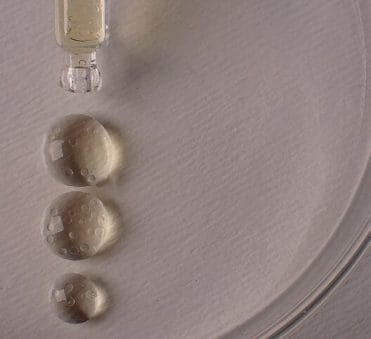
Capsum’s beauty bubbles are both functional and fun. But the company is also imaginative and innovative in the manufacturing equipment sector, in just-in-time ingredient production, and in sustainable water use. “What makes Capsum so unique is our R&D,” affirms Ricart. “For instance, we design, in-house, our very industrial equipment, using [the mechanisms of] 3D printing, to be able to push the essential fluids of an emulsion into tiny tubes creating the product, drop by drop.”
“Our vision of beauty,” she says, “is to propose the best to our clients on every single aspect: quality, sustainability, cleanliness, efficacy. That’s why we opened a best-in-class factory in Austin, Texas, in 2020 (LEED-Silver-certified plant, 100% solar powered, using Solar Water® for our production needs, a sustainable source of water for which we’ve been awarded by Innocos as Best Blue Beauty Innovative Ingredient award in 2023). That’s also the reason why we opened this year a Precision Indoor Farm in Austin to grow in a protected and optimal environment, and locally extract, sustainable and efficient actives. This will allow seed-to-jar, yet innovative, storytelling.”
“Capsum is (and wants to stay) a state-of-the-art innovation partner for brands from concept formula to product delivery!”
Ours is a World of Wonder
There are, undeniably, many more than 5 companies transforming beauty with the science of tomorrow. Nonetheless, I hope that the examples here will help you see the wonder in your own work, remind you to remain curious, and inspire you to find value in change.

Deanna Utroske
Deanna Utroske is Editor of the weekly Beauty Insights newsletter and one of the most well-respected critical thinkers in the cosmetics and personal care industry today. She serves our industry as a public speaker, writer, and consultant for supply-side companies.
As a regular contributor to this publication, Deanna writes the Global Perspectives column, covering cosmetic and personal care product formulation trends, emerging ingredient science, and ingredient marketing trends impacting the future of beauty around the world.
As a public speaker, Deanna addresses company teams, higher-education classrooms, and event audiences. She’s spoken at Cosmoprof Worldwide Bologna, in-cosmetics global, MakeUp in Los Angeles, NYSCC Suppliers Day, the Anti-Ageing Skin Care Conference, the International Cosmetics Innovation Conference, Cosmoprof North America, the AIRS International Conference on Genomics & Microbiomics, and many others.
Learn more and find a link to subscribe to the Beauty Insights newsletter at www.DeannaUtroske.com



